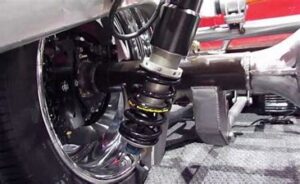Any motorist can find it confusing and alarming hearing about coolant overflowing from reservoir in their vehicle. Imagine opening the hood to find a colored liquid leaking out of the allotted container. It is a warning that something in your car’s cooling system might need to be fixed, not just a random spill. To put it simply, the coolant acts as the manager of temperature in your car. During those lengthy travels or stuck in traffic, it prevents the engine from overheating.
However, it’s like your car’s way of alerting you to a problem when it decides to depart its allotted home and form a tiny puddle under your car. We’ll solve the puzzle of coolant overflow in this post by examining its definition and causes. We’ll explore the typical causes of your car possibly pulling this surprising prank on you. So continue reading if you’ve ever puzzled why your engine appears to love making a colorful pool under the hood. Our goal is to demystify the intricacies so you can confidently and more fully comprehend the coolant overflow problem.
Table of Contents
Understanding About The Overflowing Coolant From Your Car’s Reservoir
A car’s coolant reservoir overflowing is similar to a small-scale flood beneath the hood, except that the specific liquid that keeps the engine cool replaces the water. Consider the engine in your car as a diligent machine that experiences heat while operating. A special liquid called coolant runs through the engine to help cool it down. The coolant now has a designated area called the reservoir where it is intended to remain. However, occasionally, for various reasons, it chooses to rebel and overflow. This overflow indicates that the reservoir is overflowing with coolant and is beginning to spill.
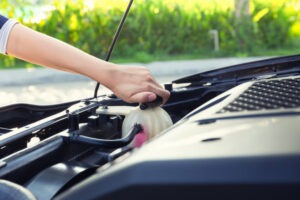
Imagine it as your favorite beverage overflowing from a glass when you unintentionally pour too much. This overflow in an automobile could indicate a problem with the cooling system of the engine. It could be a little malfunction, such as a cap failing to function, or a more significant one, such as a damaged component. Put simply, your automobile is trying to alert you that something is wrong with its cooling system when it overflows the reservoir with coolant. Please examine and correct it before I become agitated and too heated.” It’s important to recognize this problem and take quick action to keep your car cool and you happy as you drive down the road.
Common Causes Of The Coolant Overflowing From Reservoir Of Your Car
It can be confusing when your automobile overflows the coolant reservoir, but the first step in fixing the problem and maintaining the best possible condition for your car is knowing what the typical causes are.
1. Radiator Cap Malfunction:
A broken radiator cap is one of the main causes of coolant overflow. The purpose of this cap is to keep the cooling system’s pressure at the proper level. In the event that it doesn’t, too much pressure may build up and the coolant may overflow. A quick and easy fix for a malfunctioning radiator cap is to inspect and replace it.
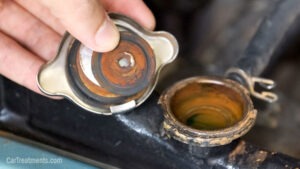
2. Thermostat Malfunction:
In order to control the engine temperature, the thermostat is essential. When it malfunctions, it can either stay open and cause the coolant to circulate excessively or stay closed and cause overheating. Coolant overflow may arise from either situation. Such problems can be avoided with routine inspections and prompt repair of a malfunctioning thermostat.
3. Overly High Cooling System Pressure:
The coolant may occasionally overflow due to an increase in pressure inside the cooling system. A obstruction in the system that prevents the coolant from flowing smoothly could be the cause of this. In order to ensure optimal performance and avoid overflow, regular cleaning of the cooling system can assist remove any debris or blockages.
4. Low Level Of Coolant:
Low coolant level is a straightforward, but frequently disregarded, cause of coolant overflow. The system’s capacity to efficiently absorb and release heat is diminished by insufficient coolant, which increases the risk of overheating and even overflow. To prevent this problem, make sure the coolant level is regularly checked and maintained.
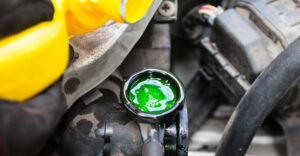
5. Blown Head Gasket:
A blown head gasket is a more dangerous source of coolant overflow. This part keeps coolant and oil from mixing by sealing the engine’s cylinders. Overheating and overflow may result from the head gasket failing and allowing coolant to enter the combustion chamber. A blown head gasket needs to be repaired quickly and professionally.
6. The Cooling System’s Air Pockets:
The presence of air pockets in the cooling system can interfere with the coolant’s flow, resulting in an uneven distribution and possible overflow. Smooth coolant circulation is ensured by properly bleeding the cooling system during maintenance, which helps get rid of these air pockets.
Therefore, there are a number of reasons behind the coolant overflowing from reservoir in cars, from simple problems like a broken radiator cap to more complicated problems like a burst head gasket. Maintaining the performance of your car and avoiding coolant-related issues require routine maintenance, quick detection of warning indications, and early repairs. You may prevent coolant overflow and have trouble-free driving by being watchful and taking care of these common culprits.
Solutions To Address Coolant Overflow In Your Car
It’s time to get your hands dirty and fix the problem when the coolant in your automobile is vanishing from the reservoir. Thankfully, there are workable answers available that don’t call for a doctorate in automotive engineering. Now let’s explore some easy but efficient strategies to maintain the proper level of coolant in your system.
1. Examine And Swap Out The Radiator Cap:
Unbelievably, the little radiator cap has a big impact. Overflowing coolant might result from improper sealing. Examine the cap for any obvious damage, and replace it with a new one if it appears worn out or broken. This simple solution can have a profound impact.
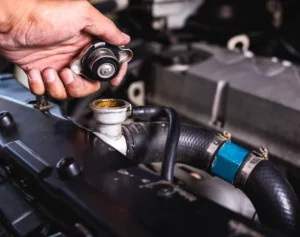
2. Examine Your Thermostat:
The thermostat regulates the temperature in your car, acting as its gatekeeper. Overheating may result from a malfunctioning thermostat that messes up the coolant’s flow. Verify that it is opening and closing properly. If not, you might want to replace it in order to get the temperature control system in your automobile back in balance.
3. Track Pressure In The Cooling System:
Overly high pressure within the cooling system has the potential to cause problems by inciting the coolant to rebel. To make sure the pressure is within the advised range, use a pressure tester. Should it be excessively elevated, there may be an obstruction or a broken part that requires fixing.
4. Look For Any Leaks:
Like hidden agents, coolant leaks are difficult to detect but can cause havoc. Check for leaks on a regular basis in the radiator, connectors, and hoses. If any are discovered, address them right once to stop additional coolant loss.
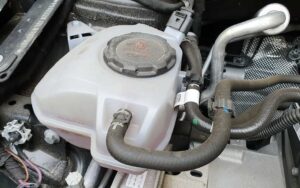
5. Filling The Coolant And Flushing It:
Coolant may become polluted and lose its efficacy over time. Regularly flushing the cooling system and replenishing it with new coolant is a wise habit. This keeps your coolant operating at optimal efficiency while also assisting in preventing overflow.
6. Pay Close Attention To The Temperature Gauge:
There’s a reason your car has a temperature gauge installed. Take note of it when operating a vehicle. Something is wrong if you see the needle start to creep into the red area. After letting the engine cool down, stop and look at the problem.
Therefore, to put it briefly, solving coolant overflow problems entails routine inspections, straightforward repairs, and some detective work. You’ll be the hero by stopping your coolant from going rogue by adding these fixes into your routine auto maintenance. Recall that a happy car is equal to a happy cooling system!
Conclusion:
In conclusion, you should act quickly if you see coolant overflowing from reservoir. Serious engine problems can be avoided by comprehending the causes and putting easy fixes in place. A healthy cooling system is ensured by routine maintenance, such as inspecting the radiator cap and keeping an eye on the thermostat. You can keep your car in good working order and protect it from future damage by taking care of these issues right now. Keep in mind that maintaining the smooth operation of your car only requires a little maintenance. When traveling, be alert, take precautions, and relish the piece of mind that comes with a properly maintained cooling system.
![You are currently viewing Coolant Overflowing From Reservoir [Simple Solutions]](https://hydraulicsuspension.com/wp-content/uploads/2024/02/Coolant-Overflow-Tank-2.jpg)

